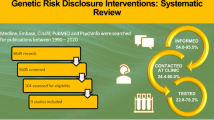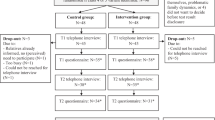Abstract
Genetic information may have health and reproductive implications for the proband and their family members. The responsibility for communicating this information within families generally lies with the proband or consultand. Previous research has explored the barriers and facilitators to communication, particularly in families affected with familial cancer syndromes. This study is an exploration of families' experiences, which aims to elucidate the process of communicating genetic information in families affected with non-cancer genetic conditions. The methodology involved 12 semi-structured interviews with probands, consultands and their family members. There were six different genetic conditions present in the families: adrenoleukodystrophy (n=3), cystic fibrosis (n=3), fragile X syndrome (n=1), haemochromatosis (n=1), balanced reciprocal chromosomal translocation (n=3) and Robertsonian chromosomal translocation (n=1). The results presented arise from two key themes, (1) the diagnosis and (2) post diagnosis. The interview data illustrate that the time of the diagnosis is a traumatic experience for families and that communication stimulated by this event revolves around informing family members about the diagnosis, but not warning them of their genetic risk. Post diagnosis, the collection of information about the genetic condition and continued communication to more distant family members, often using pre-existing family communication patterns, enables the continuation of communication about the genetic condition.
Similar content being viewed by others
Log in or create a free account to read this content
Gain free access to this article, as well as selected content from this journal and more on nature.com
or
References
Forrest LE, Delatycki MB, Skene L, Aitken M : Communicating genetic information in families – a review of guidelines and position papers. Eur J Hum Genet 2007; 15: 612–618.
Sermijn E, Goelen G, Teugels E et al: The impact of proband mediated information dissemination in families with a BRCA1/2 gene mutation. J Med Genet 2004; 41: e23.
Wertz DC, Fletcher JC, Berg K in: (ed): Review of Ethical Issues in Medical Genetics. Geneva: World Health Organization, 2003.
Sudell A : To tell or not to tell: the scope of physician–patient confidentiality when relatives are at risk of genetic disease. J Contemp Health Law Policy 2001; 18: 273–295.
Australian Law Reform Commission and Australian Health Ethics Committee (ALRC/AHEC): Essentially yours: the protection of human genetic information in Australia. Sydney: Australian Law Reform Commission, 2003. (Report No. 96).
Claes E, Evers-Kiebooms G, Boogaerts A, Decruyenaere M, Denayer L, Legius E : Communication with close and distant relatives in the context of genetic testing for hereditary breast and ovarian cancer in cancer patients. Am J Med Genet A 2003; 116A: 11–19.
Daly MB, Itzen M, Costalas JW, Balshem A : The communication of BRCA1 and BRCA2 test results to at risk relatives. Breast Cancer Res Treat 1997; 46: 38.
d'Agincourt-Canning L : Experiences of genetic risk: disclosure and the gendering of responsibility. Bioethics 2001; 15: 231–247.
Denayer L, De Boeck K, Evers-Kiebooms G, Van den Berghe H : The transfer of information about genetic transmission to brothers and sisters of parents with a CF-child. Birth Defects Orig Artic Ser 1992; 28: 149–158
Julian-Reynier C, Eisinger F, Chabal F et al: Disclosure to the family of breast/ovarian cancer genetic test results: patient's willingness and associated factors. Am J Med Genet 2000; 94: 13–18.
Kenen R, Ardern-Jones A, Eeles R : We are talking, but are they listening? Communication patterns in families with a history of breast/ovarian cancer (HBOC). Psychooncology 2004; 13: 335–345.
Sorenson JR, Jennings-Grant T, Newman J : Communication about carrier testing within hemophilia A families. Am J Med Genet C Semin Med Genet 2003; 119C: 3–10.
Ormond KE, Mills PL, Lester LA, Ross LF : Effect of family history on disclosure patterns of cystic fibrosis carrier status. Am J Med Genet C Semin Med Genet 2003; 119C: 70–77.
Lehmann LS, Weeks JC, Klar N, Biener L, Garber JE : Disclosure of familial genetic information: perceptions of the duty to inform. Am J Med 2000; 109: 705–711.
Gaff CL, Clarke AJ, Atkinson P et al: Process and outcome in communication of genetic information within families: a systematic review. Eur J Hum Genet 2007; 15: 999–1011.
Galvin KM, Brommel BJ : Family Communication: Cohesion and Change, 5th edn. New York: Addison-Wesley Longman Inc, 1999.
Minuchin S : Families and Family Therapy. Cambridge, MA: Harvard University Press, 1974.
Landsbergen K, Verhaak C, Kraaimaat F, Hoogerbrugge N : Genetic uptake in BRCA-mutation families is related to emotional and behavioral communication characteristics of index patients. Fam Cancer 2005; 4: 115–119.
Lewis S, Curnow L, Ross M, Massie J : Parental attitudes to the identification of their infants as carriers of cystic fibrosis by newborn screening. J Paediatr Child Health 2006; 42: 533–537.
McGivern B, Everett J, Yager GG, Baumiller RC, Hafertepen A, Saal HM : Family communication about positive BRCA1 and BRCA2 genetic test results. Genet Med 2004; 6: 503–509.
Forrest K, Simpson SA, Wilson BJ et al: To tell or not to tell: barriers and facilitators in family communication about genetic risk. Clin Genet 2003; 64: 317–326.
Fanos JH, Johnson JP : Barriers to carrier testing for adult cystic fibrosis sibs: the importance of not knowing. Am J Med Genet 1995; 59: 85–91.
Forrest Keenan K, Simpson SA, Wilson BJ et al: It's their blood not mine': who's responsible for (not) telling relatives about genetic risk? Health Risk Soc 2005; 7: 209–226.
MacDonald DJ, Sarna L, van Servellen G, Bastani R, Giger JN, Weitzel JN : Selection of family members for communication of cancer risk and barriers to this communication before and after genetic cancer risk assessment. Genet Med 2007; 9: 275–282.
Strauss A, Corbin J : Basic of Qualitative Research: Grounded Theory Procedures and Techniques. London: Sage, 1990.
Liamputtong P, Ezzy D : Making sense of qualitative data: analysis process; in: Liamputtong P, Ezzy D (eds): Qualitative Research Methods, 2nd edn. South Melbourne: Oxford University Press, 2005, pp 257–285.
Talarico JM, Rubin DC : Flashbulb memories are special after all; in phenomenology, not accuracy. Appl Cogn Psychol 2007; 21: 557–578.
Hill V, Sahhar A, Aitken M, Savarirayan R, Metcalfe S : Experiences at the time of diagnosis of parents who have a child with a bone dysplasia resulting in short stature. Am J Med Genet A 2003; 122A: 100–107.
Dent KM, Carey JC : Breaking difficult news in a newborn setting: Down syndrome as a paradigm. Am J Med Genet C Semin Med Genet 2006; 142C: 173–179.
Ablon J : Parents' responses to their child's diagnosis of neurofibromatosis 1. Am J Med Genet 2000; 93: 136–142.
Hughes C, Lerman C, Schwartz M et al: All in the family: evaluation of the process and content of sisters' communication about BRCA1 and BRCA2 genetic test results. Am J Med Genet 2002; 107: 143–150.
Raupach JCA, Hiller JE : Information and support for women following the primary treatment of breast cancer. Health Expect 2002; 5: 289–301.
Skinner D, Schaffer R : Families and genetic diagnoses in the genomic and Internet age. Infants Young Child 2006; 19: 16–24.
Koocher GP, Pollin I : Medical crisis counseling: a new service delivery model. J Clin Psychol Med Settings 1994; 1: 291–299.
Wright C, Kerzin-Storrar L, Williamson PR et al: Comparison of genetic services with and without genetic registers: knowledge, adjustment, and attitudes about genetic counselling among probands referred to three genetic clinics. J Med Genet 2002; 39: 84e.
Suthers GK, Armstrong J, McCormack J, Trott D : Letting the family know: balancing ethics and effectiveness when notifying relatives about genetic testing for a familial disorder. J Med Genet 2006; 43: 665–670.
Acknowledgements
We thank the individuals who agreed to be involved in this study, the Australian Research Council for funding this project and the Murdoch Childrens Research Institute and Genetic Health Services Victoria for their ongoing support.
Author information
Authors and Affiliations
Corresponding author
Rights and permissions
About this article
Cite this article
Forrest, L., Curnow, L., Delatycki, M. et al. Health first, genetics second: exploring families' experiences of communicating genetic information. Eur J Hum Genet 16, 1329–1335 (2008). https://doi.org/10.1038/ejhg.2008.104
Received:
Revised:
Accepted:
Published:
Issue date:
DOI: https://doi.org/10.1038/ejhg.2008.104
Keywords
This article is cited by
-
A tailored approach to informing relatives at risk of inherited cardiac conditions: results of a randomised controlled trial
European Journal of Human Genetics (2022)
-
Parents’ perspectives, experiences, and need for support when communicating with their children about the psychiatric manifestations of 22q11.2 deletion syndrome (22q11DS)
Journal of Community Genetics (2022)
-
Perceptions of genetic testing in patients with hereditary chronic pancreatitis and their families: a qualitative triangulation
European Journal of Human Genetics (2021)
-
Informing relatives at risk of inherited cardiac conditions: experiences and attitudes of healthcare professionals and counselees
European Journal of Human Genetics (2019)
-
Disclosure of diagnosis to at-risk relatives by individuals diagnosed with hypertrophic cardiomyopathy (HCM)
Journal of Community Genetics (2019)



